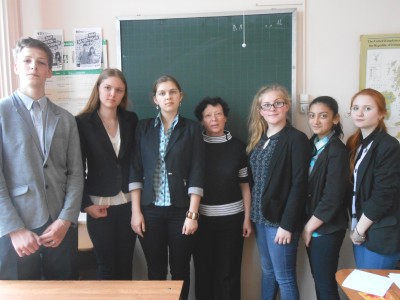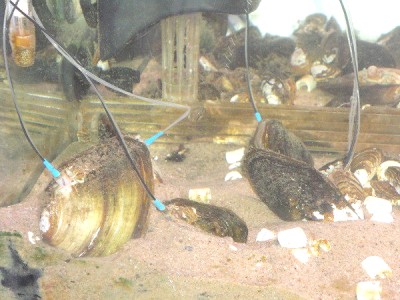Experimental work by class 10 of Lyceum 179 in St Petersburg on clams as cheap and sensitive indicators of water pollution
by A. Obukhovskaya, Biology Teacher, and Alla Kushkha, English teacher at Lyceum 179
In recent years, methods for biological monitoring are widely used associated with the use of reactions of biomarkers for aquatic environmental pollution. Physiological biomarkers (cardiac activity, respiration, motor activity) are effective tools for biological monitoring, as they reflect the body's response to exposure to pollutants and provide information on the restoration of the ecosystem at the organism level.
 This study, have been completed by the students of the 10th class of the Lyceum 179 in St. Petersburg Alexander Barazenko and Maria Druzenko under the direction of the candidate biological sciences, A. Obukhovskaya, in 2013. Over 6 months, they have studied the effect of detergents on bivalves using the original fiber-optic method. In this study, they used one of the most common detergents - lauritsulfat sodium (born sodium lauryl sulfate, SLS) or sodium dodecyl sulfate - sodium lauryl sulfuric acid, an anionic surfactant. It is used in industry as a strong cleaning and wetting agent, engine oils, in the manufacture of most detergents, shampoo, toothpaste, cosmetics foam formation.
This study, have been completed by the students of the 10th class of the Lyceum 179 in St. Petersburg Alexander Barazenko and Maria Druzenko under the direction of the candidate biological sciences, A. Obukhovskaya, in 2013. Over 6 months, they have studied the effect of detergents on bivalves using the original fiber-optic method. In this study, they used one of the most common detergents - lauritsulfat sodium (born sodium lauryl sulfate, SLS) or sodium dodecyl sulfate - sodium lauryl sulfuric acid, an anionic surfactant. It is used in industry as a strong cleaning and wetting agent, engine oils, in the manufacture of most detergents, shampoo, toothpaste, cosmetics foam formation.
The Objective
Experimental determination of concentration SLS, causing violations defined in bivalves.
Tasks
-
Master the equipment, allowing to determine the heart rate of shellfish.
-
Show the importance of shellfish for the early detection of pollution by detergents.
Materials and Methods
The object of the study were freshwater bivalve molluscs, Anodonta cygnaea, size 55-70 mm, collected in the littoral zone of the Gulf of Finland in the Park "Dubky" in 2013. which are an important part of aquatic ecosystems, essential to their functioning.
Clams were kept in a glass aquarium (150 l.) with an aeration system and water filtration by artificial lighting (12 St. / 12 so hours) and a water temperature of 16 º C. Filtered tap water used. Twice a weekly partial water change was made. The animals were acclimated to laboratory conditions for 7 days. One day before the start of the experiment optical sensors (weighing less than 1 g) were glued to the shells of mollusks. In total, 8 individuals of shellfish were used to each experiment. The effects of detergent sodium dodecyl sulfate (sodium lauryl sulfate, SDS) on shellfish was Investigated in the concentrations 2.5, 5 and 25 mg / l. Clams were contained in water with detergent for 24 hours. After that, they were kept in clean water to restore the background level of the heart rate.
Results
 On the basis of this method of bioindication, there is the effect, according to which the animals are in good physiological condition (of relatively clean habitats) have a short recovery period, and shellfish from contaminated areas are characterized by a long period of recovery.
On the basis of this method of bioindication, there is the effect, according to which the animals are in good physiological condition (of relatively clean habitats) have a short recovery period, and shellfish from contaminated areas are characterized by a long period of recovery.
As functional loadings dramatic increase salinity (by adding 6 g / L NaCl) were used for 1 hour.
The study was performed at the Laboratory of bioelectronic methods of geo-environmental monitoring Observatory in St. Petersburg Scientific Research Center for Ecological Safety Russian Academy of Science.
The students came to the following conclusions:
-
The registration study of cardiac activity in shellfish using the original fiber-optic method, during exposure to sodium lauryl sulfate, showed high sensitivity and rapid response of shellfish to pollution.
-
in terms shellfish could replace crabs that are currently used to determine the extent of water pollution in the laboratories of Wodocanal St. Petersburg, or used as bio tests with them.
-
The proposed research method allows for taking rapid measures to prevent the accumulation of toxic substances in the environment.
The results were presented in Rospotrebnadzor and the local newspaper. The story was told in English as well as a contribution to celebrate World Oceans Day 2014. World Oceans Day is celebrated each year on 8 June following a decision of the General Assembly of the United Nations.








